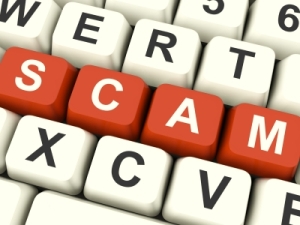Recently, for the first time in my career (and hopefully the last time), I got scammed. That’s right, I’ve been fooled and tricked into translating a document that I will never be paid for. While this has been a very painful realization and a bitter feeling to wonder why I have been so naive, I would like to take this opportunity to speak about this topic – and more specifically to touch on ways to protect yourself against being scammed, but also on how important it is to look at the bright side of things, which is sometimes a very difficult thing to do when one finds oneself in such an undesirable and unfortunate situation.
Picture by Stuart Miles for FreeDigitalImages.net
How to prevent being scammed
- Look at where your client comes from – where and how did they find you? Is that source safe or is it known for being a hub for scammers and phishers? If it is, pay double attention to the following points.
- ALWAYS follow your gut. While negotiating with my “client”, I had a bad feeling about a few things, and I didn’t follow my intuition, which I now bitterly regret.
- Professional image counts, even for clients – and yes, even if they are individuals. Weird spelling and grammar, lack of signature can (but not always, of course) all point towards the same thing: your client is not who they say they are (i.e. they are probably established in another country), and they probably stole someone’s identity. Googling that person is then useless, unfortunately.
- Always check your client’s email address. If it doesn’t make any sense (i.e. [email protected]), this person probably wants to con you.
- Always pay attention at how long it takes your client to answer you. Constant delays don’t bode well. I know, people have a life, they work, they have kids, etc. But they’ve hired you and they’re willing to spend money on your work, so real clients will ask you to provide updates about how the translation process is going and will give you more information in a timely manner. Also, if your client says they come from Europe but you seem to receive their emails during the night, they’re probably lying.
- Never accept sketchy payment methods (checks being the most suspicious).
- The type of document should be consistent with the information your client gives you. My client told me the document wasn’t designed to be published or anything. When I had a closer look at it, it looked like a school presentation – now, who on earth has the kind of money to translate such a thing?
Now, if one of those points proves to be true, it doesn’t necessarily mean you’re facing a scammer. Do give your client the benefit of the doubt, but keep your eyes open!
Look at the bright side!
I know, if you’ve been scammed, you probably were angry for a whole day, if not a whole week, you were utterly shocked at your naiveness and you are lost at you can possibly do to get those numerous hours you spent working hard on that translation. Being conned is a very unpleasant experience and I’m not denying it in any way. But to ease things a bit, why not try and look at the positive side of it? After all, every cloud has a silver lining.
- You increased your knowledge in your area of specialization. You might have indeed learned about a few concepts that you weren’t aware of, and you will be more ready for when that next project about the same topic comes.
- You were thus probably able to add a few new terms to your terminology base, which will result in faster and more efficient translations later – you win in productivity!
- If you’re holding a total count of the words you have translated throughout your career, this project counts as well.
- It gave you more experience.
- Finally, and this is the most important in my opinion: you know better. You now have the tools to recognize scams, even well disguised ones, and you won’t be caught next time!
More on the subject?
- Translators facing scam agencies, fake profiles, and other “con artists”: how to prevent their attacks?
- Lesson 61: How to protect your CV from scammers?
- Translator Scammers Directory
Related Posts







